YELLOWSTONE can destroy the world as we know it.
West of the Mississippi gets the initial dump from the eruption.
US eastern Seaboard is under ash to the point that it is unusable.
Atlantic is acidified and most fish and life dies off.
Europe is shut down for over a month with 90% Casualties.
China and Asia suffer 80% causalities.
Africa, Australia and South America become the dominant world powers during the ice age that follows.
Volcano

The reason that Yellowstone has so many amazing thermal features such as geysers, mudpots, and fumaroles is the volcanic activity underneath the surface. Yellowstone has a large caldera, which is a collapsed volcano, that encompasses a large portion of the park. Most people don’t realize as they drive into the central geyser basins in Yellowstone, that they are actually driving into a volcano! Check the map below to look at the region that the Yellowstone caldera encompasses. Teton County extends to the southwestern edge of Yellowstone Lake, so technically part of the caldera is in our county:

Click for a larger view
I’m sure many of you have seen, or at least have heard of, the docu-drama “Supervolcano”. One of the more popular questions Emergency Management has received following this production is, “Will that happen here?” The answer is that we don’t know for sure, but we will prepare our citizens by teaching them about the risk, and also give them instructions on how to prepare. The National Park Service and the USGS set up a great website answering some of the more common questions that have come up in regards to the “Supervolcano” movie, and you can access that page here.
What are the risks?
Since catastrophic geologic events occur so rarely, it is difficult to calculate the exact risks of another event, but that is no reason to be unprepared:
- Proximity to a volcanically active area.
There is debate among scientists what is considered “active”. The last eruption of the Yellowstone caldera occurred about 70,000 years ago, while the last catastrophic eruption was 600,000 years ago. The largest eruption was approximately 2 million years ago, and the diagram below puts those eruptions into context:
Click for larger view is one of five USGS volcano observatories in the United States. In partnership with the University of Utah and the National Park Service, the observatory constantly monitors the status of the Yellowstone caldera for any abnormalities and continuously records geologic data. Each month they provide a report on geologic activity in the area, which is available on their website.
is one of five USGS volcano observatories in the United States. In partnership with the University of Utah and the National Park Service, the observatory constantly monitors the status of the Yellowstone caldera for any abnormalities and continuously records geologic data. Each month they provide a report on geologic activity in the area, which is available on their website.
With all of that said, many scientists do not know if Yellowstone’s caldera will ever have another catastrophic eruption. Based on Yellowstone’s past history, the possibility of another caldera-forming eruption is 0.00014%. Realize, however, that this is only based on the 3 past major eruptions, so it is hardly close to being statistically accurate. Either way, there is currently no evidence to suggest that a catastrophic event at Yellowstone is imminent, and such events are unlikely to occur in the next few centuries (USGS).
Historically there have been smaller eruptions and lava flows in Yellowstone as well, and it is possible for these to occur again. Scientists, however, have no evidence to suggest that these types of events will occur in the near future either.
- Living downstream along the predominant jetstream from other volcanically active areas.
 Teton County can be affected by a volcano without the eruption of the Yellowstone caldera. One of the most volcanically active areas in the United States today is the Pacific Northwest. Since Teton County lies to the east of this area (which is the predominant wind direction), we can be affected by ash and other gases as they are carried away from the eruption site.In the diagram to the right (courtesy of the Seattle Times), you can see how within 9 hours the ash plume from the May 18, 1980 eruption of Mount St. Helens reached Teton County. Although we only received a dusting, there were several citizens who were taken to the hospital due to respiratory issues from the ash.
Teton County can be affected by a volcano without the eruption of the Yellowstone caldera. One of the most volcanically active areas in the United States today is the Pacific Northwest. Since Teton County lies to the east of this area (which is the predominant wind direction), we can be affected by ash and other gases as they are carried away from the eruption site.In the diagram to the right (courtesy of the Seattle Times), you can see how within 9 hours the ash plume from the May 18, 1980 eruption of Mount St. Helens reached Teton County. Although we only received a dusting, there were several citizens who were taken to the hospital due to respiratory issues from the ash. After looking at the ash distribution from the Mount St. Helens eruption, look again at this diagram to put it into context with the major eruptions of the Yellowstone caldera. Then click on the map to the left to see how the ash fall from Mount St. Helens compares to that of the prehistoric eruptions of the Yellowstone caldera.
After looking at the ash distribution from the Mount St. Helens eruption, look again at this diagram to put it into context with the major eruptions of the Yellowstone caldera. Then click on the map to the left to see how the ash fall from Mount St. Helens compares to that of the prehistoric eruptions of the Yellowstone caldera.
What should I do?
Information and advance warning are key to reacting to a volcanic event:
- As for any disaster, have a plan and preparedness kit ready for your family.
If you don’t have a family emergency plan and a 72 hour kit, click hereto get started. - Have a pair of goggles and disposable breathing mask for every family member in your 72 hour kit.
 These items should be in your kit anyway due to their usefulness not only in a volcanic event, but in the event of pandemic flu, earthquake, or any others where there are particulates in the air that you don’t want to have in contact with your eyes or respiratory system.Volcanic ash is essentially pulverized rock and glass which is abrasive, gritty, gassy, and odorous. Although it is not immediately dangerous to most adults, infants or the elderly are particularly at risk. Those with respiratory problems also need to take special precautions. If available, everyone should wear respiratory masks. If not available, a damp cloth held over the nose and mouth can help to filter out the ash.If you wear contact lenses, you should remove them. They can trap irritants against your eye or may react to the gases carried by the wind from the eruption. Everyone should wear eye protection if available.
These items should be in your kit anyway due to their usefulness not only in a volcanic event, but in the event of pandemic flu, earthquake, or any others where there are particulates in the air that you don’t want to have in contact with your eyes or respiratory system.Volcanic ash is essentially pulverized rock and glass which is abrasive, gritty, gassy, and odorous. Although it is not immediately dangerous to most adults, infants or the elderly are particularly at risk. Those with respiratory problems also need to take special precautions. If available, everyone should wear respiratory masks. If not available, a damp cloth held over the nose and mouth can help to filter out the ash.If you wear contact lenses, you should remove them. They can trap irritants against your eye or may react to the gases carried by the wind from the eruption. Everyone should wear eye protection if available.
- Stay tuned to EAS broadcasts for instruction before, during, and following the disaster.
 Listen to your NOAA All-Hazards Weather Radio or another Emergency Alert System (EAS) broadcaster for instructions from emergency services before, during, and following a disaster. Lava flows are typically slow moving, so evacuation orders can be given well in advance. Emergency services will also give instruction on how to deal with ash or whether it will be necessary to shelter in place.
Listen to your NOAA All-Hazards Weather Radio or another Emergency Alert System (EAS) broadcaster for instructions from emergency services before, during, and following a disaster. Lava flows are typically slow moving, so evacuation orders can be given well in advance. Emergency services will also give instruction on how to deal with ash or whether it will be necessary to shelter in place. - If told to evacuate, do so immediately.
It is also important that you follow the routes given to you for evacuation by emergency services. Some roads may be impassable due to landslides, ash fall, or lava flows. - Wear long sleeve shirt and pants.
This will reduce the amount of contact your skin has with abrasive and irritating ash. - Stay indoors until the ash has settled, unless there is danger of roof collapse.
It will be easier to get around once the ash has settled, but especially if it begins to rain be aware that ash can become very heavy. Try to monitor the amount of ash on your rooftop and make arrangements to remove it if it becomes too heavy. - Use shelter in place procedures.
Shut all windows, doors, and vents. Turn off any HVAC units that may be bringing ash into the structure. - Clear heavy ash from flat or low-pitched roofs.
 Luckily in Teton County, many structures are designed with roofs to slough off snow in the winter, which will also help with shedding volcanic ash in the event of an eruption. If ash does accumulate, shovel it off of the roof and out of gutters while wearing goggles, a dust mask, and long pants and shirt.
Luckily in Teton County, many structures are designed with roofs to slough off snow in the winter, which will also help with shedding volcanic ash in the event of an eruption. If ash does accumulate, shovel it off of the roof and out of gutters while wearing goggles, a dust mask, and long pants and shirt. - Avoid running engines or driving in heavy ash fall.
 Volcanic ash can easily clog engines, damage moving parts, and stall engines with its abrasive properties. Also, driving in depths of ash is not like driving in deep snow; as mentioned before, ash can easily clog engines and stall out vehicles.
Volcanic ash can easily clog engines, damage moving parts, and stall engines with its abrasive properties. Also, driving in depths of ash is not like driving in deep snow; as mentioned before, ash can easily clog engines and stall out vehicles. - Educate yourself.
Ready.gov has a site with information on volcanoes and what to do in the event of an eruption. The USGS also has some detailed information on volcano monitoring, preparedness actions, and more here.
What are the impacts?
A catastrophic large-scale eruption of the Yellowstone caldera would have dire impacts on the entire world, and not just Teton County. To learn about those, check the Yellowstone Volcano Observatory FAQ here. Impacts discussed below are considering smaller eruptions:
- Loss of life and damage to property.
Loss of life is the primary impact, and secondary to that is the damage to property. Ash, being made of pulverized rock and glass, can get into ventilation systems, engines, and buildings rendering vehicles and structures unusable. - Cascading events.
 Even a non-catastrophic volcanic eruption is a large-scale event. Like an earthquake, it is the other disasters that are triggered by the volcano that can make the event even more complicated. Volcanoes can trigger landslides, avalanches, flash floods, wildfires, weathersuch as acid rain, and other disastrous events.
Even a non-catastrophic volcanic eruption is a large-scale event. Like an earthquake, it is the other disasters that are triggered by the volcano that can make the event even more complicated. Volcanoes can trigger landslides, avalanches, flash floods, wildfires, weathersuch as acid rain, and other disastrous events. - A long and expensive recovery effort.
Even without lava flows and pyroclastic events, the amount of ash that can be deposited following an eruption presents an expensive logistical problem for affected communities. Ash and lava can cause extensive damage to critical infrastructure and utilities as well. - Economic losses.
Not only is the recovery effort expensive, but if people are unable to leave their homes due to hazardous conditions outside, businesses will suffer.
U.S. Geological Survey
Fact Sheet 100-03
2004
Tracking Changes in Yellowstone’s Restless Volcanic System
| The world-famous Yellowstone geysers and hot springs are fueled by heat released from an enormous reservoir of magma (partially molten rock beneath the ground). Since the 1970s, scientists have tracked rapid uplift and subsidence of the ground and significant changes in hydrothermal (hot water) features and earthquake activity. In 2001, the Yellowstone Volcano Observatory was created by the U.S. Geological Survey (USGS), the University of Utah, and Yellowstone National Park to strengthen scientists’ ability to track activity that could result in hazardous seismic, hydrothermal, or volcanic events in the region |
In the 1970s, a resurvey of benchmarks discovered the unprecedented uplift of the Yellowstone Caldera of more than 28 inches (72 cm) over five decades. More recently, new and revolutionary satellite-based methods for tracking the Earth’s shifting ground motions have enabled University of Utah, U.S. Geological Survey, and other scientists to assemble a more precise and detailed picture of Yellowstone’s ground movements.
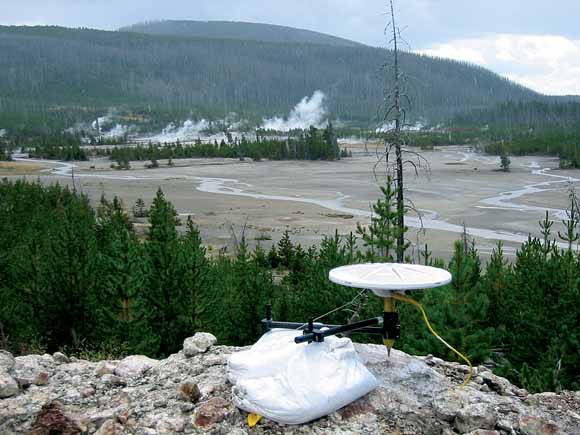 |
| Global Positioning System (GPS) stations like this one in the Norris Geyser Basin can detect changes in elevation and horizontal shifts of 1 inch or less per year, helping scientists understand the processes that drive Yellowstone’s active volcanic and earthquake systems. (Photo courtesy of Christine Puskas, University of Utah.) |
No actual volcanic eruption has occurred in the Yellowstone National Park region of Wyoming, Montana, and Idaho since a lava flow poured out about 70,000 years ago. However, the area’s many geysers and hot springs indicate that the underlying volcanic system remains active. In the early 1970s, Earth scientists found evidence that this system was more active than even these spectacular hydrothermal (hot water) features had suggested.
One important clue was found along the south shore of Yellowstone Lake, where trees were dying because their trunks were partly below water and a boat dock had become completely submerged. At the same time, the water level at the lake’s outlet on its north side appeared little changed.
Scientists reasoned that these observations could be explained by southward tilt of the area around Yellowstone Lake, including the lake basin itself. If the entire area was being pushed up, perhaps the ground at the north end of the lake was rising more than the south end, like a giant bathtub lifted at one end. In this way, the water level of Yellowstone Lake would appear to rise at the south end.
To test this idea, in 1975–77 scientists from the University of Utah and the U.S. Geological Survey (USGS) resurveyed a series of benchmarks along roads throughout Yellowstone National Park. These benchmarks were originally installed and their elevations and locations precisely determined in 1923. The results of the resurvey showed dramatically that the central part of the park had indeed risen. The greatest uplift appeared to be in the area of Le Hardy Rapids on the Yellowstone River, a few miles downstream from the lake’s outlet. There the ground had risen 28.5 inches (72 cm) since 1923, raising the nearby north end of Yellowstone Lake much more than the south end. Scientists then focused their attention on what could be causing the ground to rise and whether the uplift was still going on.
Yellowstone Caldera and its resurgent domes
The 1975–77 survey showed that the area of recent uplift was located within the Yellowstone Caldera, a shallow, oval depression, 53 miles long and 28 miles across (85 by 45 km), in the middle of the park. This caldera was formed 640,000 years ago during the most recent of Yellowstone’s great volcanic eruptions. In that eruption, 240 cubic miles (1,000 km3) of molten rock (magma) was blasted into the atmosphere and scattered on the Earth’s surface-more than 1,000 times the volume erupted at Mount St. Helens in 1980! The ground then collapsed into the partly emptied magma reservoir, forming an enormous craterlike depression.
Later eruptions of many large lava flows, some as thick as 400 feet (120 m), buried the original caldera floor and most of the caldera walls. Mount Washburn, a prominent landmark in the park, is a section of the caldera rim that escaped burial. The most recent series of eruptions at Yellowstone, 160,000 to 70,000 years ago, covered much of the caldera floor with more than 20 thick lava flows, including the Elephant Back flow, which can be seen west of Fishing Bridge.
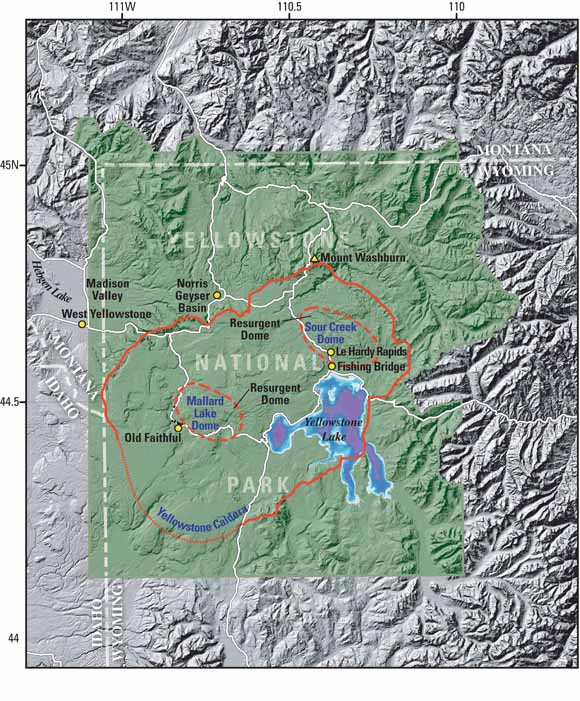 |
| The region of Yellowstone National Park in Wyoming, Montana, and Idaho is famous for its spectacular geysers and extensive hot springs, indications that an underlying volcanic system remains active. The central part of the park is occupied by the great, partly filled depression of the Yellowstone Caldera, formed in a giant volcanic eruption 640,000 years ago that blasted 240 cubic miles (1,000 km3) of molten rock (magma) into the atmosphere-more than 1,000 times the volume erupted at Mount St. Helens in 1980. Later eruptions largely filled the caldera and pushed up two resurgent domes within it—the Sour Creek and Mallard Lake Domes. No actual volcanic eruption has occurred in the Yellowstone region for about 70,000 years. However, since the 1970s, scientists have detected significant changes in this remarkable volcanic and hydrothermal (hot water) system, including rapid ground uplift and subsidence and bursts of earthquake activity. |
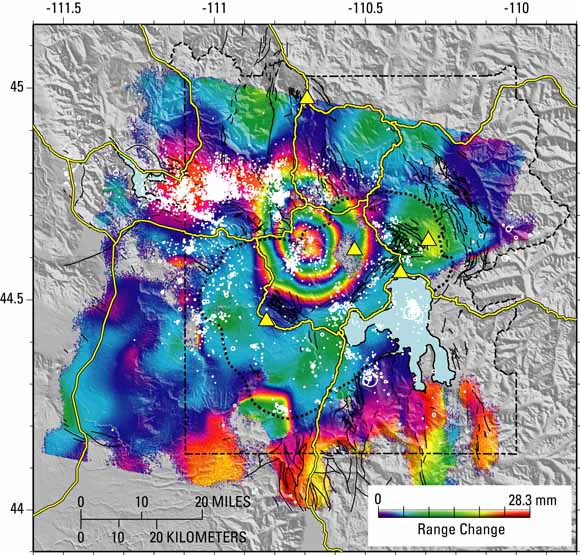 |
| A new satellite-based technique known as Interferometric Synthetic Aperture Radar (InSAR) allows direct and precise measurement of the vertical changes in ground level. This InSAR image of the area around the Yellowstone Caldera (dotted line) shows vertical changes during the 4-year period 1996–2000. The ringed pattern centered northwest of Yellowstone Lake is a prominent area of dome-shaped uplift. Each complete cycle of colors in the color bands represents a little more than one inch (28.3 mm) of vertical change. Yellow triangles are continuous GPS stations; white dots are locations of earthquakes in the period 1996–2000. |
The uplift detected in the 1970s was centered near Le Hardy Rapids, between two resurgent domes-sections of the caldera floor that had earlier been pushed upward and faulted. Such resurgent domes form when magma rises to shallow levels beneath a caldera and slowly reinflates a previously depleted magma reservoir, pushing the overlying caldera floor upward to form a dome. The pressure of the inflating magma reservoir may even force some of the molten rock to emerge at the surface as lava.
The fact that the uplift documented in the 1970s was centered within the caldera near the resurgent domes seemed to indicate that the magma reservoir was again exerting pressure upward. What could be causing this? Was new magma entering Yellowstone’s enormous reservoir from below? Perhaps volcanic gas was escaping from the magma reservoir, percolating upward and causing the surface to bow upward? Perhaps some of Yellowstone’s hot water had become trapped beneath the surface, exerting pressure on the caldera floor from below? New volcano-monitoring data soon forced scientists to think again about what was occurring beneath Yellowstone’s active caldera.
The ups and downs of the caldera’s movements
To learn more about the changing ground levels in the Yellowstone area, scientists conducted additional surveys across the eastern part of the caldera nearly every year from 1983 to 1998. In the 1990s, new and revolutionary satellite-based methods for tracking the Earth’s changing ground surface—the Global Positioning System (GPS) and Interferometric Synthetic Aperture Radar (InSAR)—were applied by University of Utah, USGS, and other scientists to assemble a more detailed picture of how and when the ground moves above Yellowstone’s magma reservoir.
These new data reveal that Yellowstone is in nearly continuous but frequently changing movement—the floor of the caldera continued to rise until 1984, stopped rising during 1984–85, and then subsided for the next 10 years. Parts of the central caldera began rising again in 1995, but a more complex pattern of uplift and subsidence has prevailed since 2000. InSAR data show that between 1995 and 1997 a large area along the northwest rim of the Yellowstone Caldera, centered near Norris Geyser Basin, started to rise. The picture that emerges from all these data is of a dynamic system in which the caldera floor is in almost constant motion—episodes of uplift and subsidence occur at various locations and over different time scales.
What could cause different areas in and around the caldera to go up and down over such short time intervals? A clue to this mystery, and a further indication that the region remains an active volcanic system, is the frequency and distribution of earthquakes at Yellowstone, one of the most seismically active areas in North America.
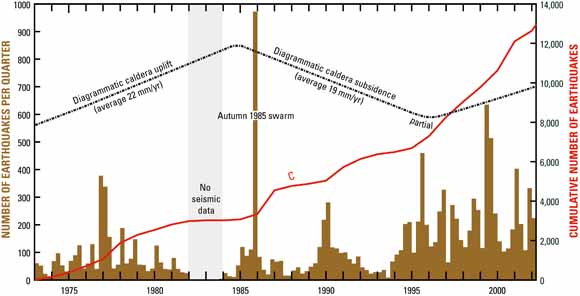 |
| The Yellowstone area is one of the most seismically active parts of the United States, but the frequency of earthquakes varies dramatically and is related to other events in this active volcanic system. Precise measurements of elevation made regularly since the 1970s document the rise and fall (shown diagrammatically here) of the ground surface in the Yellowstone Caldera, thought to be caused by movements of magma (molten rock) or hydrothermal (hot, watery) fluids beneath the surface. The spectacular earthquake swarm of late 1985 may have been caused by the escape of hydrothermal fluids through the impermeable rock layer above the magma reservoir, which also initiated an episode of subsidence in the caldera. |
Earthquakes at Yellowstone
Thousands of small earthquakes rattle the Yellowstone region each year, and at least eight magnitude 6 or greater quakes have occurred in historical time. The largest was the magnitude 7.5 Hebgen Lake earthquake, which struck about 15 miles (24 km) northwest of the Yellowstone Caldera on August 18, 1959. That earthquake killed 28 people and caused damage of $11 million (equivalent to $70 million in 2003 dollars). The most recent large earthquake was a magnitude 6.1 shock inside the Yellowstone Caldera near Norris Geyser Basin on June 30, 1975.
An early written account of Yellowstone’s earthquakes was given by Ferdinand Hayden in 1872, when his survey party was camped on the northeast shore of Yellowstone Lake:
| We were informed by mountain-men that these earthquake shocks are not uncommon, and at some seasons of the year very severe, and this fact is given by the Indians as the reason why they never visit that portion of the country. I have no doubt that if this part of the country should ever be settled and careful observations made, it will be found that earthquake shocks are of very common occurrence. |
So common were these shocks at Yellowstone Lake that Hayden named this camp “Earthquake Camp,” an apt name because the area remains one of the most common sites of earthquake swarms in the Yellowstone region.
To document and monitor this seismic activity, the USGS installed a permanent network of instruments in 1973. University of Utah and USGS scientists have since pinpointed the locations of thousands of earthquakes in the Yellowstone region. Most are small (magnitude less than 3), shallow quakes that sometimes occur in swarms lasting days to weeks or longer. Swarms have been located both within the caldera and between the caldera and the rupture zone of the Hebgen Lake earthquake to the northwest. Although many earthquakes are associated with known active faults or former sites of volcanic eruptions (vents), some are not.
The migrating earthquake swarm of 1985
The largest earthquake swarm recorded at Yellowstone since 1973 occurred just northwest of the caldera beginning in October 1985. Over the next several months, more than 3,000 earthquakes struck the upper Madison Valley area—more than 100 of them were felt near West Yellowstone, Montana. Previously, only about 100 total earthquake epicenters had been located in this area. During the 1985 swarm, as many as 100 to 200 events per day occurred from October 16 to 20, and the two largest events (magnitudes 4.9 and 4.3) struck on November 9.
A new analysis by University of Utah scientists of the 1985 swarm shows that during the first month the locations of earthquakes moved to the northwest, away from the rim of the Yellowstone Caldera, along a narrow zone at an average rate of 500 feet (150 m) per day. For the rest of the swarm, into the following year, the earthquake locations grew systematically deeper, from less than 2 miles (3 km) to more than 5 miles (8 km) deep, at an average rate of about 80 feet (25 m) per day. This intense earthquake swarm generally coincided in time with the 1985–86 reversal of ground movement in the central part of the caldera-from uplift to subsidence. Was there a common trigger for both sets of events?
A likely cause of the 1985 earthquake swarm, according to scientists, was the rupture of a widespread layer of impermeable rock (through which fluids cannot pass) above the magma reservoir. The rupture of this rock layer allowed pressurized hydrothermal fluids (hot watery solutions) to move upward and laterally out of the caldera and into an adjacent network of fractures over a period of many weeks. As the fluids pushed through this network, cracks were opened and adjacent rocks were broken, resulting in several thousand small quakes. At the same time, according to this model, the lateral escape of fluids through the impermeable layer dramatically decreased the upward pressure normally exerted by the hydrothermal system beneath the caldera, resulting in subsidence there.
Another earthquake swarm occurred at Yellowstone in 1995. Because this swarm was not accompanied by caldera subsidence but rather by the latest period of caldera uplift, it has led scientists to ponder other possible models that link magma intrusion, hydrothermal fluid migration, and uplift of the caldera.
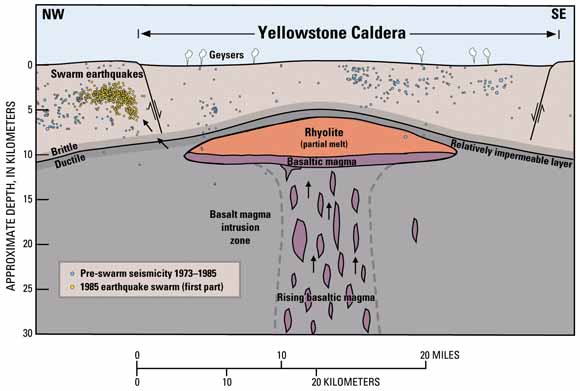 |
| Volcanic and hydrothermal activity in the Yellowstone area is fueled by a large reservoir of magma (partially molten rock) beneath a caldera (volcanic depression) that formed in a cataclysmic eruption 640,000 years ago. The magma reservoir includes both rhyolitic magma, rich in silica (SiO2), and basaltic magma, which contains less SiO2 and is denser. Capping the magma reservoir is a zone of hot, ductile rock that can slowly flow to close any fractures and is therefore relatively impermeable (meaning that fluids cannot easily pass through). The cooler rock above behaves in a more brittle manner and can be readily fractured. Sometimes the impermeable rock can be ruptured, allowing hot, salty fluids to escape upward and laterally, moving through cracks in brittle rock. As shown in this diagram, such a fluid release in 1985 is thought to have triggered a large swarm of earthquakes just northwest of the caldera. |
Monitoring future activity
The Yellowstone Volcano Observatory (YVO), by facilitating collaboration among Earth scientists and focusing scientific attention on the active geologic processes in Yellowstone, aims to increase our ability to forecast potential consequences of these processes. Those future consequences could be large destructive earthquakes, hydrothermal explosions, or volcanic eruptions. Forecasting whether hot pressurized fluids or even molten rock moving beneath Yellowstone will erupt at the surface depends on the ability of scientists to detect the changing activity by real-time monitoring and on understanding how the vast Yellowstone volcanic system, and other similar systems, work and behave. An ever-improving monitoring system will undoubtedly contribute to this understanding and reveal new aspects of Yellowstone’s underground volcanic system.
Future monitoring at Yellowstone will seek answers to questions such as these:
- Is ground deformation caused by rising magma or by increased fluid pressure within the hydrothermal system?
How can the underground migration of liquids and gases be detected? What changes does such activity produce in the hydrothermal fluids that emerge at the surface?
Coordination of scientists’ efforts by the Yellowstone Volcanic Observatory will lead to better understanding of the region’s remarkable volcanic and hydrothermal system and ultimately to a greater ability to predict potentially hazardous events. This work at Yellowstone is only part of the ongoing efforts by the USGS Volcano Hazards Program to protect people’s lives and property in all of the volcanic regions of the United States, including the Pacific Northwest, California, Alaska, and Hawaii.
The Yellowstone Volcano Observatory
Increased scientific surveillance of Yellowstone in the past 30 years has detected unmistakable changes in its vast underground volcanic system, similar to historical changes observed at many other large calderas (volcanic depressions) in the world. To strengthen the capabilities of scientists to track and respond to changes in Yellowstone’s activity, a fifth U.S. volcano observatory was created in 2001, complementing existing ones for Hawaii, Alaska, the Cascades, and Long Valley, California. The Yellowstone Volcano Observatory (YVO) is supported jointly by the U.S. Geological Survey, the University of Utah, and Yellowstone National Park.The principal goals of YVO include:
|
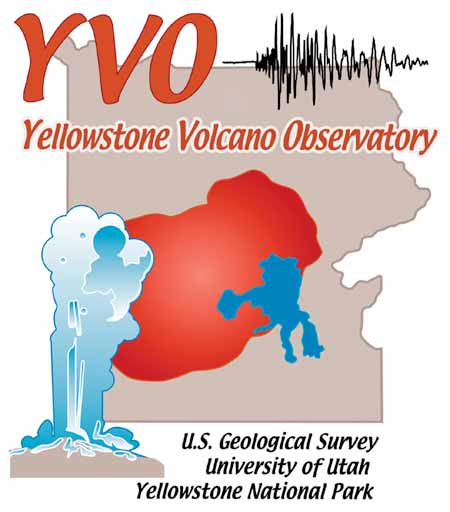 |
By Steven R. Brantley, Jacob B. Lowenstern, Robert L. Christiansen, Robert B. Smith, Henry Heasler, Greg Waite, and Charles Wicks
Edited by Peter H. Stauffer
Graphic design by Sara Boore and Susan Mayfield
Banner design by Bobbie Myers
COOPERATING ORGANIZATIONS
Yellowstone National Park
University of Utah
For questions about the content of this report, contact Steve Brantley
For more information contact:
U.S. Geological Survey
(650) 329–5227
http://volcanoes.usgs.gov/yvo
or
Yellowstone National Park
http://www.nps.gov/yell/home.htm
PDF version of this fact sheet (2.1 MB)
- How are changes to the magma reservoir linked to and reflected in the overlying hydrothermal system?